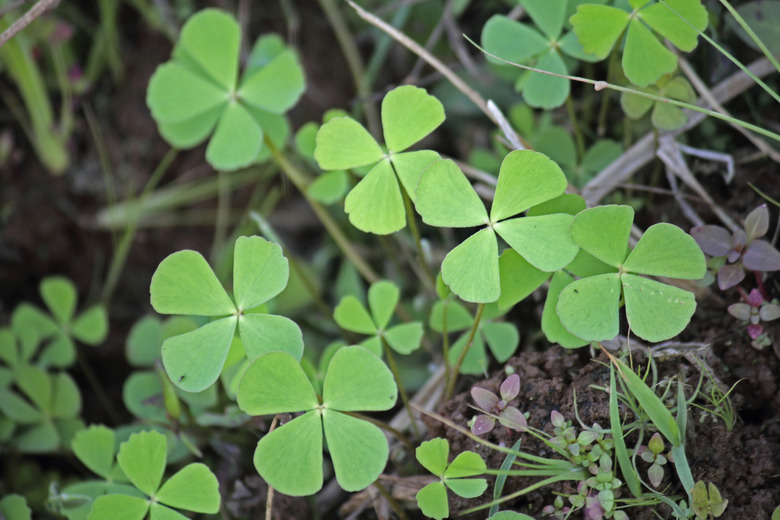Lawn Weed With A Clover Leaf And Small Yellow Flower
We may receive a commission on purchases made from links.
A clover-like yellow flowering plant wandering its way across your lawn is most likely either creeping woodsorrel (Oxalis corniculata, USDA zones 4-8) or Bermuda buttercup (Oxalis pes-caprae, zones 8-11). These two members of the sour-leafed Oxalis genus can be weedy and invasive. Woodsorrel is more likely to create problems in your lawn, while Bermuda buttercup often crawls across garden beds, occasionally spreading into lawns.
Creeping Across Lawns
Creeping Across Lawns
Creeping woodsorrel is a 4-inch-tall perennial weed that's an extremely competitive and aggressive plant, surviving and thriving in sun or shade. Its heart-shaped leaves are reminiscent of Dutch clover (Trifolium repens, zones 3-10) and can be green to purple in color.
Woodsorrel blooms year-round, with the largest flower burst in spring. The blooms are bright yellow with five petals per flower. Woodsorrel seedpods are designed to spread. They are long and slightly sticky, giving them the ability to stick to clothing or fur and be moved to a new area. When mature, the pods burst open and expel seeds up to 10 feet.
A Similar Cousin
A Similar Cousin
Bermuda buttercup is a close cousin of creeping woodsorrel. It prefers full sun and grows up to 14 inches tall. It has the same three-leafed clover appearance, but will sometimes have spots on the leaves. It produces yellow flowers in late winter to early spring.
Bermuda buttercup is not nearly as invasive as woodsorrel and won't often overtake lawns, but you may find it in your gardens. Dig the plant up because it has bulbs beneath the soil that you need to remove to effectively control it.
Woodsorrel Natural Remedies
Woodsorrel Natural Remedies
Woodsorrel can easily take over a lawn and it's important you remove it before it sets seed. Try to remove it in winter, when it's dormant. Mowing is ineffective because the plant can still grow and set seeds because it's low-growing. Pull dormant plants out of the ground and then dig or till the area to break up the roots. Repeat this whenever you see new seedlings.
You will have to patch the lawn if you've removed a large section of woodsorrel. If you mow a lawn with seeds from this plant, rinse your mower before using it on another piece of lawn that does not have the weed.
Woodsorrel Chemical Remedies
Woodsorrel Chemical Remedies
Woodsorrel is quite resistant to herbicides, but there are some chemical, postemergent options. Organic solutions include horticultural vinegar and herbicidal soap, although you will need to be persistent with their application to get results. A heads-up is that horticultural vinegar will also damage or kill plants that surround woodsorrel if the liquid splashes on their leaves.
If you decide to use a chemical, use a selective postemergent variety, so it will not harm your lawn. Apply in early spring before the woodsorrel starts blooming. Products that contain a combination of MCPA, triclopyr and dicamba work well to eliminate Oxalis plants. Check the label before you buy because not all selective herbicides are suitable for all species of lawn grass. In a chemical sprayer, mix a solution of the chemical and water, according to the rates on the label.
Spray the solution directly on the leaves until they appear wet. Do not spray newly seeded grasses or mow for two days before application. When working with garden chemicals, wear long pants, a long-sleeved shirt, socks, shoes, protective eyewear and chemical-resistant gloves.
